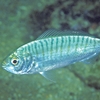General Description
Body very long, compressed, gradually tapering to a shallow tail base; dorsal fin single, arising over or behind end of gill cover, well before anus; pectoral fin longer than eye diameter; anal fin joined to tail or to base of tail fin; membranes between anal fin rays distinctly notched at edge. Orange to white with a broad dark brown stripe on head and sides, stripe with narrow white border above and below. To 11 cm.
Biology
These well-camouflaged fishes are rarely seen.
Habitat
On shallow rocky reefs, usually amongst rubble in depths of 0-15 m.
Reefs
Distribution guide
Southern Australia.
Species Group
Fishes › Weedfishes and snakeblennies
Depth
Shore (0-1 m)
Shallow (1-30 m)
Water Column
Max Size
11 cm
Commercial Species
No
Global Dispersal
Native to Australia
Conservation Status
- DSE Advisory List : Not listed
- EPBC Act 1999 : Not listed
- IUCN Red List : Not listed





